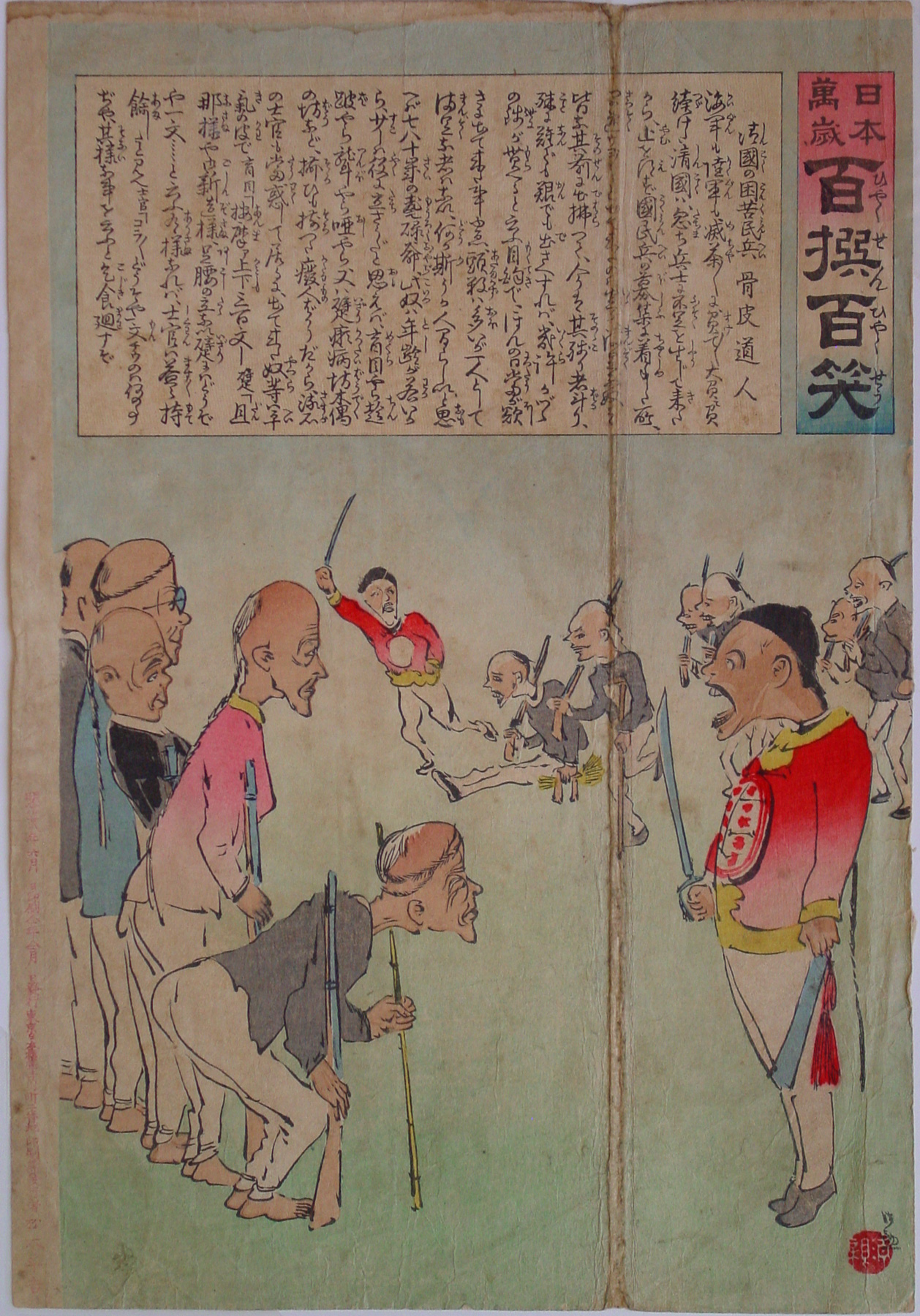About This Print
This print is one of fifty prints from the first part of the three part series One Hundred Victories, One Hundred Laughs. (Hyakusen hyakushô) created by the artist Kobayashi Kiyochika (1847-1915), the writer Nishimori Takeki (1861-1923), alias Koppi Dōjin, and the publisher Matsuki Heikichi (1870-1931).
In front of a Chinese officer holding a sword are a line of new recruits - old senile men. In the background another Chinese officer marching with various disabled recruits. While the war was over when this print was published in August 1895, it was still popular to ridicule the Chinese military.
About The Series One Hundred Victories, One Hundred Laughs
This series One Hundred Victories, One Hundred Laughs was issued in three parts and presented parodies of the enemy, the Chinese in the Sino-Japanese War of 1894-1895 and ten years later the Russians in the Russo-Japanese War of 1904-1905. The first part of the series titled Long Live Japan: One Hundred Victories, One Hundred Laughs, consisting of fifty prints, was issued between September 1894 and August 1895. The second part of the series titled Magic Lantern Society: One Hundred Victories, One Hundred Laughs, consisting of twelve prints, was issued between November 1895 and December 1896. Both of these parts parodied (often in a racist manner) the Chinese people, leadership and war effort. The third and last part of the series, consisting of eight-six prints, used the same title as the first part Long Live Japan: One Hundred Victories, One Hundred Laughs. Issued between April 1904 and April 1905, the prints parodied the Russian war effort. For more information about the series see the article One Hundred Victories, One Hundred Laughs on this site.
Print's Inscription - Japanese and English
海軍(かいぐん)も陸軍(りくぐん)も目茶目茶(めちやめちや)に負(まけ)て負(まけ)て大負ニ負/続(つづ)ける清国(しんこく)ハ、忽(たちま)ち兵士(へいし)に不足(ふそく)を生(しやう)じて来(き)た/ から止(やむ)を得(え)ず国民兵(こくみんへい)の募集(ぼしふ)に着手(ちやくしゆ)した所、/ 早速(さつそく)ウヨウヨと出て来たのハ宣(いい)が、満足(まんぞく)な奴は/ 皆な其前(そのぜん)に出佛(ではら)つて、今は其(その)残(のこ)り者升(ばか)り、/ 殊(こと)に難(なん)でも銀(かん)でも出さへすれバ、幾許(いくら)かづつ/ の銭(ぜに)が貰(もら)へると云ふ目的(もくてき)で、ほんの日当(につとう)が欲(ほし)/ さにでて来た事ゆへ頭数(あたまかず)ハ多いが一人として/ 満足(まんぞく)な者ハない、何(どう)か斯(か)うか人間らしいと思(おも)/ へバ七八十歳(さい)の 耄碌爺(もうろくおやじ)、此奴(こやつ)ハ年齢(とし)が若(わか)いか/ら、少(すこ)しハ役(やく)に立(たち)さうだと思(おも)えバ、盲目(めくら)やら珍(ちん)/跛(ば)やら聾(つんぼ)やら唖(おし)やら、又ハ躄(いざり)癩病坊(かつたいぼう)木偶(でく)/の坊(ぼう)など、揃(そろ)ひも揃(そろ)つた廃人(かたわもの)ばかりだから、流石(さすが)/ の士官も当惑(とうわく)して居るに、出て来た奴等(やつら)ハ平(へい)/気(き)の皮(かわ)で盲目「按摩(あんま)ァ上下(うえした)三百文 - 躄「旦(だん)/那様(なさま)や御新造様(ごしんぞさま)、足腰(あしこし)の立(たた)ない躄(いざり)にハどうぞ/ や一文 - と云ふ有様(ありさま)なれバ、士官(しかん)ハ益々(ますます)持(もて)/餘(あま)したと見へ士官「コラコラどうぞや一文(もん)チウのハ何の事 / ぢや、其様(そのよふ)な事を云ふと乞食(こじき)廻(まわ)すぞ
Shinkoku konkuminhei Koppi Dōjin
Kaigunmo rikugun mo mechamecha ni makete ōmake ni make/tsuzukeru Shinkoku wa,tachimachi heishi ni fusoku o shōjitekita/ kara yamu o ezu kokuminheino boshū ni chakushu shita tokoro,/ sassoku uyouyo to detekita no wa iiga, manzoku na yatsu wa/ mina sono zen ni deharatte, ima wa sononokori–mono bakari,/ koto ni nan de mo kan de mo de sae sureba, ikuraka zutsu/ no zeni ga moraeru to iu mokuteki de, hon no nittō gahoshi/sa ni detekita koto yue atama-kazu wa ōi ga hitori to shite/manzoku na mono wa nai, dō ka kō ka ningen rashii to omo/ebashichihachijussai no mōroku-oyaji, koyatsu wa toshi ga wakai kara,sukoshi wa yaku ni tachisō da to omoeba, mekura yara chin/ba yaratsunbo yara oshi yara, mata izari kattaibō deku/nobō nado, soroi mosorotta katawa-mono bakari da kara, sasuga no shikan mo tōwaku shiteiru ni, detekita yatsura wa hei/ki no kawa de Mekura “Anmā ue shitasanbyakumon” Izari “Dan/na-sama ya go-shinzo-sama, ashi koshi notatanai izari ni wa dōzo/ ya ichimon” to iu arisama nareba, shikan wamasumasu mote/amashita to mie Shikan “Korakora douzo ya ichimon chū nowa nan no koto/ ja, sono yō na koto o iu to kojikimawasu zo”
Source: University of Vienna website http://ukiyoe.univie.ac.at/detail.asp?docid=944&lang=e&first=1
The hardship of the Chinese militia [by] Koppi Dōjin
The navy and also the army was smashed in a great defeat. Consequently, an evident shortage of soldiers forced China, which continued (the war), to attempt recruiting for military service. Though it's good that immediately many people appeared in droves, useful fellows had run out already and now only those are left over who participate in everything with the intention to make money. As they appeared following the urge to receive a daily wage, the headcount is great but not one useful fellow is among them.
If you look for someone who is still a human being, then you'll find senile old men of 70 or 80 years of age, or if it's young men who are useful, you'll find only blind, lame, deaf and mute men, maybe even cripples sliding around on their knees as well as lepers and good-for-nothings etc. All of them human waste.
That's why the officer became desperate when the men stood in front of him with excessive self esteem.
Blind man: “A massage from head to toe makes 300 mon.”
Hampered man: “Dear sir or dear madame; one mon for a lame man who can't stand, please.”
Now the officer is completely angry and depressed.
Officer: “Hey, hey, stop it! Why are you talking about money? If you talk like this I will mop the floor with you beggars. (Send you to the beggars.)”
Print Details
| IHL Catalog | #247 |
| Title or Description | New Army Recruits Shinkoku konku minpei 清国の困苦民兵 |
| Series | Long Live Japan: One Hundred Victories, One Hundred Laughs [also translated as Long Live Japan! One Hundred Selections, One Hundred Laughs] Nihon banzai: Hyakusen hyakushō 日本萬歳 百撰百笑 [日本万歳 百撰百笑] |
| Artist | Kobayashi Kiyochika(1847-1915) |
| Signature | Kiyochika |
| Seal | Kiyochika |
| Publication Date | August 1895 (Meiji 28) |
| Publisher | Matsuki Heikichi (松木平吉) proprietor of Daikokuya |
| Impression | excellent |
| Colors | excellent |
| Condition | poor - staining throughout, vertical fold, full size, not backed |
| Genre | ukiyo-e - senso-e (Sino-Japanese War); giga; fūshiga |
| Miscellaneous | |
| Format | vertical oban |
| H x W Paper | 14 1/2 x 9 3/4 in. (36.8 x 24.8 cm) |
| H x W Image | 14 x 9 1/4 in. (35.6 x 23.5 cm) |
| Literature | |
| Collections This Print | The Tsubouchi Memorial Theatre Museum of Waseda University 201-1828; Princeton University Art Museum 2008-102.23 |


